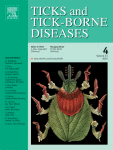Ver ítem
- xmlui.general.dspace_homeCentros Regionales y EEAsCentro Regional Santa FeEEA RafaelaArtículos científicosxmlui.ArtifactBrowser.ItemViewer.trail
- Inicio
- Centros Regionales y EEAs
- Centro Regional Santa Fe
- EEA Rafaela
- Artículos científicos
- Ver ítem
Ixodes silvanus n. sp. (Acari: Ixodidae), a new member of the subgenus Trichotoixodes Reznik, 1961 from northwestern Argentina
Resumen
Females, nymphs, and larvae of Ixodes silvanus n. sp. collected from birds and from the vegetation in northwestern Argentina (Yungas Phytogeographic Province) are described herein. The new species belongs to the subgenus Trichotoixodes (Acari: Ixodidae). The female is diagnosed by a combination of the following characters: scutum with setae moderately long and more numerous in central field, fewer and moderately long setae on lateral fields, and
[ver mas...]
Females, nymphs, and larvae of Ixodes silvanus n. sp. collected from birds and from the vegetation in northwestern Argentina (Yungas Phytogeographic Province) are described herein. The new species belongs to the subgenus Trichotoixodes (Acari: Ixodidae). The female is diagnosed by a combination of the following characters: scutum with setae moderately long and more numerous in central field, fewer and moderately long setae on lateral fields, and inconspicuous setae in anterior field; basis capituli subtriangular dorsally; porose areas large and irregular in shape, lacking distinct margins; auriculae with straight edges diverging posterolaterally and ending with small blunt processes; hypostome narrow and pointed with dental formula 4/4 in the anterior third, then 3/3 and 2/2 near the base; coxae I with two spurs, sub-equal in size, internal slightly slimmer than external. The nymph is diagnosed by notum with numerous and long setae, ventral surface covered by numerous whitish setae, scutum with short scapulae and few and shallow punctations, setae on scutum few, short and irregularly distributed, basis capituli sub-triangular dorsally with posterior margin straight, cornua large and directed postero-laterally, auriculae large and projected laterally, lateral margin of basis capituli above auriculae with a lateral and triangular projection, hypostome pointed with dental formula 3/3 in the anterior third and then 2/2, and coxa I with two short, sub-equal, triangular spurs. The diagnostic characters of the larva are: basis capituli dorsally sub-triangular with lateral angles acute and posterior margin straight, auriculae as large triangular lateral projections, hypostome with apex bluntly pointed and dental formula 3/3 in the anterior third and then 2/2, coxa I with two short, sub-equal, triangular spurs, and pattern of dorsal and ventral body setae. This new species is phylogenetically related to Ixodes brunneus, Ixodes turdus and Ixodes frontalis, and the principal hosts for all its parasitic stages are birds.
[Cerrar]

Autor
Saracho Bottero, Maria Noelia;
Beati, Lorenza;
Venzal, José Manuel;
Guardia Claps, Leonor;
Thompson, Carolina Soledad;
Mangold, Atilio Jose;
Guglielmone, Alberto;
Nava, Santiago;
Fuente
Ticks and Tick-borne Diseases 12 (1) : 101572 (January 2021)
Fecha
2020-09
Editorial
Elsevier
ISSN
1877-959X
Formato
pdf
Tipo de documento
artículo
Palabras Claves
Derechos de acceso
Restringido
 Excepto donde se diga explicitamente, este item se publica bajo la siguiente descripción: Creative Commons Attribution-NonCommercial-ShareAlike 2.5 Unported (CC BY-NC-SA 2.5)
Excepto donde se diga explicitamente, este item se publica bajo la siguiente descripción: Creative Commons Attribution-NonCommercial-ShareAlike 2.5 Unported (CC BY-NC-SA 2.5)

